 |
Home | Charity | Feedback |
Cambodia: Siem Reap
Siem Reap, Cambodia: Home to the world's largest temple complex by Prakash Bang, Editor in Chief 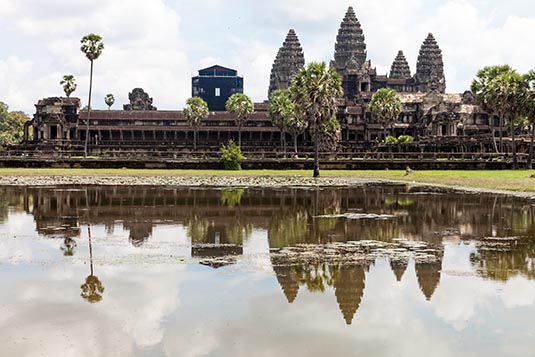 Siem Reap, a resort town in northwestern Cambodia, is the gateway to the ruins of Angkor, the seat of the Khmer kingdom from the 9th–15th centuries. The name "Siem Reap" can be translated to mean "Defeat of Siam" (Siem in Khmer), and is commonly taken as a reference to an incident in the centuries-old conflict between the Siamese and Khmer kingdoms. According to oral tradition, King Ang Chan (1516–1566) had named the town "Siem Reap", meaning "the defeat of Siam", after he repulsed an army sent to invade Cambodia by the Thai King Maha Chakkraphat in 1549. 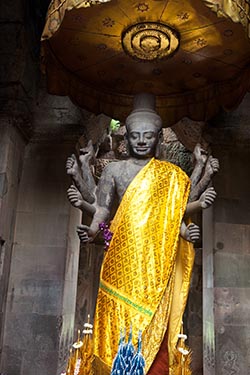 I was on a 12-day holiday of Indochina (Cambodia, Vietnam, Laos & Thailand) region. Accompanying me was my wife Vrunda. For our arrangements we had availed the services of Spirit Travel with HQ in Ho Chi Minh City, Vietnam. They had a good team of guides and drivers all throughout the trip. They surely have my recommendation. It will take months to discover most of Indochina. In our trip, the plan was to visit only the most famous of places. In Cambodia, we restricted our trip to 3 days to explore just Siem Reap.
I was on a 12-day holiday of Indochina (Cambodia, Vietnam, Laos & Thailand) region. Accompanying me was my wife Vrunda. For our arrangements we had availed the services of Spirit Travel with HQ in Ho Chi Minh City, Vietnam. They had a good team of guides and drivers all throughout the trip. They surely have my recommendation. It will take months to discover most of Indochina. In our trip, the plan was to visit only the most famous of places. In Cambodia, we restricted our trip to 3 days to explore just Siem Reap.
From the sixteenth to the nineteenth centuries, infighting among the Khmer nobility led to periodic intervention and domination by both of Cambodia's more powerful neighbors, Vietnam and Siam (now Thailand). Siem Reap, along with Battambang and Sisophon, major cities in the northwest of Cambodia, was under Siamese administration and the provinces were collectively known as Inner Cambodia from 1795 until 1907, when they were ceded to French Indochina. In 1975, the population of Siem Reap, like all other Cambodian cities and towns, was driven into the countryside by the communist Khmer Rouge. Siem Reap's recent history is coloured by the horror of the brutal Khmer Rouge regime. Since Pol Pot's death in 1998, however, relative stability and a rejuvenated tourist industry have revived the city and province. 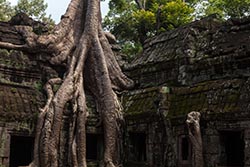 We landed in Siem Reap mid-morning. It was an hour’s flight from Bangkok. Siem Reap is well connected with many cities in the region, including Singapore, Hong Kong, China and Malaysia. Our stay was for 3 days and we were booked at Sokha Angkor Resort, a fine upscale property, located on the junction of Sivatha Street and National Road No 6.
We landed in Siem Reap mid-morning. It was an hour’s flight from Bangkok. Siem Reap is well connected with many cities in the region, including Singapore, Hong Kong, China and Malaysia. Our stay was for 3 days and we were booked at Sokha Angkor Resort, a fine upscale property, located on the junction of Sivatha Street and National Road No 6.
The town is a cluster of small villages along the Siem Reap River. These villages were originally developed around Buddhist pagodas (Wat) which are almost evenly spaced along the river from Wat Preah En Kau Sei in the north to Wat Phnom Krom in the south, where the Siem Reap River meets the Great Tonle Sap Lake. The main town is concentrated around Sivutha Street and the Psar Chas area (Old Market area) where there are old colonial buildings, shopping and commercial districts. The Wat Bo area is now full of guesthouses and restaurants while the Psar Leu area is often crowded with jewelry and handicraft shops. 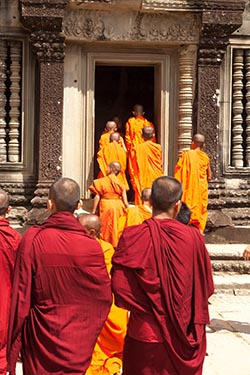 Though we were ahead of the usual check-in time, it was nice to have a room ready. A little rest and freshening up we were ready for day’s exploration. At our disposal was a comfortable van and to show us around was a local guide.
Though we were ahead of the usual check-in time, it was nice to have a room ready. A little rest and freshening up we were ready for day’s exploration. At our disposal was a comfortable van and to show us around was a local guide.
Our first visit was to a silk-making factory. We witnessed the growing of food (essentially mulberry leaves) for the silk-worms, breeding the worms, silk extraction, refinement, dyeing and weaving on hand-operated wooden looms. Next on the schedule was taking a boat from Mechhrey village for a 3-hour tour on the Great Lake of Tonle Sap to see the daily life of the lake-dwelling Cambodian people. The Tonle Sap, Khmer for "Vast Body of Fresh Water" and more commonly translated as "Great Lake" is a combined lake and river system of major importance to Cambodia. It is located in the heart of Cambodia about 30 minutes south of downtown Siem Reap and has many attractions. The area around the Tonle Sap including the province of Siem Reap is part of the Tonle Sap Biosphere Reserve. 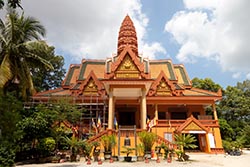 Tonle Sap is the largest freshwater lake in Southeast Asia at the end of the wet season but is only a large lake in the dry season when it shrinks to a fraction of its wet season size. Stretching almost all the way from Phnom Penh to Angkor Wat, it provides water for half of Cambodia's crops, and yields fish that supplies Cambodia’s population with half its protein. It is also one of the country’s most important transportation links.
Tonle Sap is the largest freshwater lake in Southeast Asia at the end of the wet season but is only a large lake in the dry season when it shrinks to a fraction of its wet season size. Stretching almost all the way from Phnom Penh to Angkor Wat, it provides water for half of Cambodia's crops, and yields fish that supplies Cambodia’s population with half its protein. It is also one of the country’s most important transportation links.
Before retiring for the day, we visited the Wat Thmey Temple that shook us to the roots… left our eyes moist. 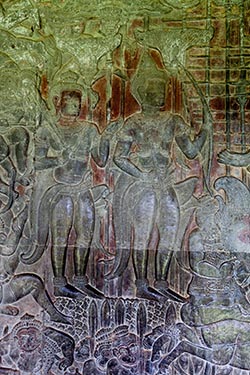 The Wat Thmey Temple is notable for being an area that served as one of the killing fields during the Khmer Rouge regime in the country. The Khmer Rouge was Cambodia’s ruling party from 1975 to 1979 and was responsible for one of the worst mass killings during the 20th Century.
The Wat Thmey Temple is notable for being an area that served as one of the killing fields during the Khmer Rouge regime in the country. The Khmer Rouge was Cambodia’s ruling party from 1975 to 1979 and was responsible for one of the worst mass killings during the 20th Century.
Under the leadership of Pol Pot, the dreaded Khmer Rouge brought Cambodia back to the old ages by forcing millions of people to leave the city and work on farms in the countryside. The communists believed that cities were tools towards capitalism. So in order to create the ideal communist society, people had to live and work in the rural areas as peasants. Peasants were viewed by the Khmer Rouge as ideal communists for the Cambodian state as they were simple, uneducated and hardworking. The evacuation of the city was the first of many radical steps taken by the Khmer Rouge. The organization then dictated the life of every Cambodian citizen with rules on religion, money and private ownership. Communications with the outside world were eliminated and family relationships were dismantled. All rights and responsibilities were eradicated as Pol Pot declared the nation to start at “Year Zero”, signifying the end of Cambodia’s 2000-year history. The Khmer Rouge arrested any person suspected of having relations with the former government or foreign affairs. Many of these arrested people were ethnic Vietnamese, ethnic Chams, Cambodian Christians and Buddhist monks. 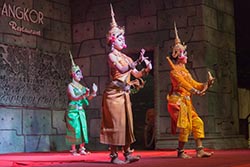 The assassinations occurred in great numbers as it happened everywhere in the country. Most of those who were executed were buried in mass graves. To save on ammunition, executions were commonly done using hammers, spades, axe handles or sharpened bamboo sticks. Many victims were even forced to dig their own graves. The Khmer Rouge killed almost 25% of the country’s population. Almost 2 million people of Cambodia were massacred or died from diseases, starvation, exhaustion and forced labour.
The assassinations occurred in great numbers as it happened everywhere in the country. Most of those who were executed were buried in mass graves. To save on ammunition, executions were commonly done using hammers, spades, axe handles or sharpened bamboo sticks. Many victims were even forced to dig their own graves. The Khmer Rouge killed almost 25% of the country’s population. Almost 2 million people of Cambodia were massacred or died from diseases, starvation, exhaustion and forced labour.
The Khmer Rouge command was finally overthrown in 1979 by the invasion of the Vietnamese troops after many violent border confrontations. In the years that followed, Cambodia went through a process of healing and reopening to the international community. Survivors told their stories as the 1980s Hollywood movie “The Killing Fields” brought the Khmer Rouge victims to worldwide attention. 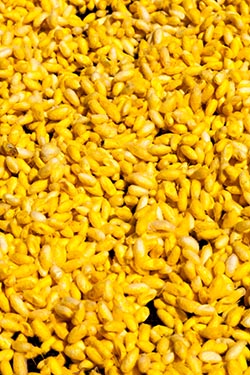 The Wat Thmey Temple is a live monastery where a large Stupa memorial can be found. The stupa has glass sides filled with the skulls and bones of those who died during the Khmer Rouge. These have been diligently gathered by local residents in memory of their families and friends. The Wat Thmey Temple is the spot of one of the terrible killing sites where hundreds of Cambodian civilians were tortured, killed and buried. The mass of bones and skulls at the stupa shows the cruel behavior of the Khmer Rouge at the time.
The Wat Thmey Temple is a live monastery where a large Stupa memorial can be found. The stupa has glass sides filled with the skulls and bones of those who died during the Khmer Rouge. These have been diligently gathered by local residents in memory of their families and friends. The Wat Thmey Temple is the spot of one of the terrible killing sites where hundreds of Cambodian civilians were tortured, killed and buried. The mass of bones and skulls at the stupa shows the cruel behavior of the Khmer Rouge at the time.
More than just a holocaust tourist spot, many have come to the Wat Thmey Temple to pay homage and to remember those who lost their lives in the Cambodia Killing Fields. It is a reminder of a dark chapter in recent Cambodian History that will always remain marked in the minds of those who had to endure it. The next day after breakfast we first visited the Main Shrine where the locals worship the statues of Yeay Teap, Preah Ang Check and Preah Ang Chorm. Offering jasmine and lotus flowers at the shrine is very important to Cambodians. The visitors to the shrine often release caged birds (there’s a cost of course) with a belief that the gesture frees them from hardship and worries. 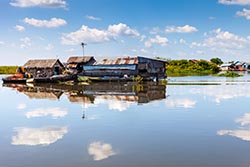 Blessed, we continued towards Psar Chars (Old Market) on the shores of Siem Reap River. These markets are famous for selling anything and everything! After enjoying a good walk along the river and the alleys of the market, we moved to Wat Bo.
Blessed, we continued towards Psar Chars (Old Market) on the shores of Siem Reap River. These markets are famous for selling anything and everything! After enjoying a good walk along the river and the alleys of the market, we moved to Wat Bo.
Wat Bo is one of the oldest pagodas in Siem Reap, and has a number of well-preserved wall paintings from the 19th century. Although it is a Buddhist temple some of the wall paintings describe the famous ancient stories of Rama and Sita, the strongest man and the most beautiful woman of all times. Even today the royal families of the Southeast Asian countries claim to be descendants of Rama. These wall paintings describe a Hindu story that is most remarkable in a Buddhist temple. 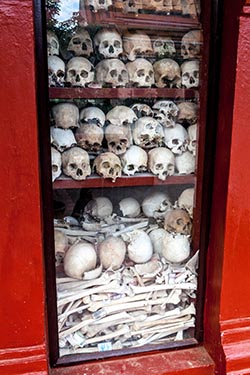 From Wat Bo we visited Angkor Panoramic museum – a must see when in Siem Reap, is what I definitely think. It’s located at the Angkor Visitor Centre. Under a dome and a combination of painting and artefacts visitors get a 3-dimensional perspective of the Angkor Era and the Khmer Civilisation.
From Wat Bo we visited Angkor Panoramic museum – a must see when in Siem Reap, is what I definitely think. It’s located at the Angkor Visitor Centre. Under a dome and a combination of painting and artefacts visitors get a 3-dimensional perspective of the Angkor Era and the Khmer Civilisation.
That evening we opted to enjoy an Apsara dance and dinner show. There are a few restaurants that offer these shows nightly followed by a lavish international buffet spread. Tomorrow, we would be visiting the Angkor Complex – the purpose of our visit to Siem Reap. Beware that the tickets to visit Angkor Wat and Angkor Thom, can be purchased only at the visitor centre. Ideally, one should reach Angkor Complex at 5:30 in the morning. That way, you could enjoy the sunrise at Angkor Wat. The complex is only about 6 kms away from downtown. The advantage of starting early is that you can get out of the open complex before it gets hot. With stones around the mid-day sun really hits you bad. Do carry sun-screen, hat and water. 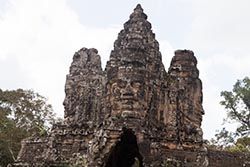 Since getting up early was not on our plan, we took it easy. We left for the complex at 9 AM after having our breakfast.
Since getting up early was not on our plan, we took it easy. We left for the complex at 9 AM after having our breakfast.
We entered via the South Gate of Angkor Thom, which is famous for its series of colossal human faces carved in stone, the impressive Bayon Temple, the Royal Enclosure, the Elephant Terrace, the Terrace of the Leper King and the largest as well as the most complete temple of Angkor Wat. The Bayon Temple is a well-known and richly decorated Khmer temple at Angkor. Built in the late 12th or early 13th century as the official state temple of the Mahayana Buddhist King Jayavarman VII the Bayon stands at the centre of Jayavarman's capital, Angkor Thom. Following Jayavarman's death, it was modified and augmented by later Hindu and Theravada Buddhist kings in accordance with their own religious preferences. 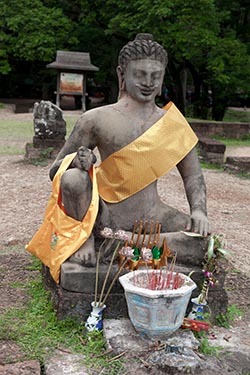 The Bayon's most distinctive feature is the multitude of serene and smiling stone faces on the many towers which jut out from the upper terrace and cluster around its central peak. The temple is known also for two impressive sets of bas-reliefs, which present an unusual combination of mythological, historical, and mundane scenes. The temple is described as "the most striking expression of the baroque style" of Khmer architecture, as contrasted with the classical style of Angkor Wat.
The Bayon's most distinctive feature is the multitude of serene and smiling stone faces on the many towers which jut out from the upper terrace and cluster around its central peak. The temple is known also for two impressive sets of bas-reliefs, which present an unusual combination of mythological, historical, and mundane scenes. The temple is described as "the most striking expression of the baroque style" of Khmer architecture, as contrasted with the classical style of Angkor Wat.
The Terrace of the Elephants was used by Angkor's king Jayavarman VII as a platform from which to view his victorious returning army. It was attached to the palace of Phimeanakas of which only a few ruins remain. Most of the original structure was made of organic material and has long since disappeared. Most of what remains are the foundation platforms of the complex. The terrace is named for the carvings of elephants on its eastern face. The 350-metre long Terrace of Elephants was used as a giant reviewing stand for public ceremonies and served as a base for the king's grand audience hall. It has five outworks extending towards the Central Square - three in the centre and one at each end. The middle section of the retaining wall is decorated with life size garuda and lions; towards either end are the two parts of the famous parade of elephants complete with their Khmer mahouts. 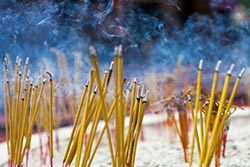 The Terrace of the Leper King was built in the Bayon style under Jayavarman VII, though its modern name derives from a 15th-century sculpture discovered at the site. The statue depicts the Hindu God Yama, the god of death. The statue was called the "Leper King" because discolouration and moss growing on it was reminiscent of a person with leprosy, and also because it fit in with a Cambodian legend of an Angkorian king Yasovarman I who had leprosy. The name that the Cambodians know him by, however, is Dharmaraja, as this is what was etched at the bottom of the original statue. The U-shaped structure is thought by some to have been used as a royal cremation site.
The Terrace of the Leper King was built in the Bayon style under Jayavarman VII, though its modern name derives from a 15th-century sculpture discovered at the site. The statue depicts the Hindu God Yama, the god of death. The statue was called the "Leper King" because discolouration and moss growing on it was reminiscent of a person with leprosy, and also because it fit in with a Cambodian legend of an Angkorian king Yasovarman I who had leprosy. The name that the Cambodians know him by, however, is Dharmaraja, as this is what was etched at the bottom of the original statue. The U-shaped structure is thought by some to have been used as a royal cremation site.
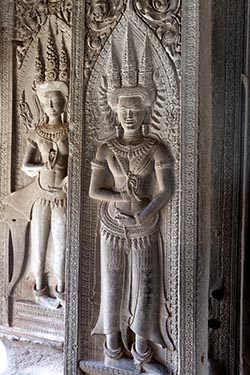 Now to drive to Angkor Wat.
Now to drive to Angkor Wat.
Angkor Wat is a temple complex and the largest religious monument in the world. It sits on a site measuring 162.6 hectares. It was originally constructed as a Hindu temple of God Vishnu for the Khmer Empire, gradually transforming into a Buddhist temple towards the end of the 12th century. It was built by the Khmer King Suryavarman II in the early 12th century in Yasodharapura, the capital of the Khmer Empire, as his state temple and eventual mausoleum. Breaking from the Shaiva tradition of previous kings, Angkor Wat was instead dedicated to Vishnu. As the best-preserved temple at the site, it is the only one to have remained a significant religious centre since its foundation. The temple is at the top of the high classical style of Khmer architecture. It has become a symbol of Cambodia, appearing on its national flag, and it is the country's prime attraction for visitors. Angkor Wat combines two basic plans of Khmer temple architecture: the temple-mountain and the later galleried temple. It is designed to represent Mount Meru, home of the devas in Hindu mythology: within a moat and an outer wall 3.6 kilometres long are three rectangular galleries, each raised above the next. At the centre of the temple stands a quincunx of towers. Unlike most Angkorian temples, Angkor Wat is oriented to the west; scholars are divided as to the significance of this. The temple is admired for the grandeur and harmony of the architecture, its extensive bas-reliefs, and for the numerous devatas adorning its walls. 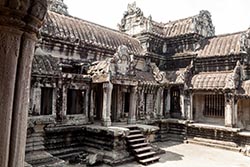 It was early afternoon by the time we left Angkor Wat. We had lunch in a restaurant around the walls and then drove to visit Ta Prohm.
It was early afternoon by the time we left Angkor Wat. We had lunch in a restaurant around the walls and then drove to visit Ta Prohm.
Ta Prohm Temple is a very popular feature of the typical Angkor tour because it is the only major stop which has not been fully reclaimed from the jungle. Many of the walls and structures have been smothered by huge silk-cotton trees and strangler figs, which grow over, around and even through the ancient stone blocks, in some cases holding them together and, in others, causing their collapse. 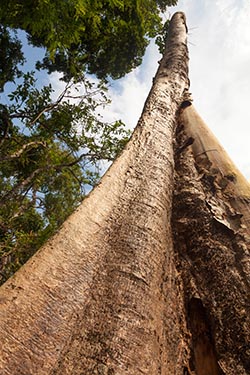 Unlike any of the other popular Angkor temples, Ta Prohm really gives you the feeling of discovering something hidden and truly ancient, giving you a real Tomb Raider or Indiana Jones vibe. In fact, this was used as a location during the filming of the 2001 movie Tomb Raider and, while other Angkor temples featured were digitally altered, Ta Prohm’s appearance was largely unchanged.
Unlike any of the other popular Angkor temples, Ta Prohm really gives you the feeling of discovering something hidden and truly ancient, giving you a real Tomb Raider or Indiana Jones vibe. In fact, this was used as a location during the filming of the 2001 movie Tomb Raider and, while other Angkor temples featured were digitally altered, Ta Prohm’s appearance was largely unchanged.
Ta Prohm Temple was actually a monastery – one of King Jayavarman VII's first major temple projects from the 12th-13th century, which was dedicated to his mother. It is estimated that this vast, 600-room structure and the surrounding area once had a population of over 70,000 people. The temple is 145 metres by 125 metres, and was home to high priests, monks, assistants, dancers and labourers. It controlled a great wealth of jewels and gold, as well as an estimated 3,000 nearby villages. The temple itself contains a maze of courtyards and galleries, and it is well worth spending some time to explore its many dark corridors. Some walls and doorways of the ancient buildings have been left overgrown and gripped by huge trees and other foliage. That was it. We were on our own for the evening. On reaching the hotel, we took a tuk-tuk for a ride around town. We enjoyed a well-deserved foot massage and had our dinner at an Indian restaurant and walked back to our hotel to rest for the night. The next morning we would leave for Ho Chi Minh City, formerly known as Saigon. Siem Reap Image Gallery  Photo viewer Photo viewer
|
|
|
Home |
Charity |
Feedback
Privacy Policy | Terms of Usage © YoGoYo.com. All rights reserved. |











































































































